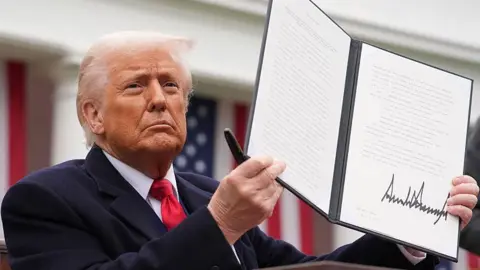 Getty Images
Getty ImagesJapan is a big deal for President Donald Trump’s upheaval of world’s trading system.
On his own terms, it could now be said that his aggressive approach is yielding tangible results.
Right from the off, the US side has been talking up the chances of a deal with Japan, but despite several delegations, the deal had been strangely elusive – until now.
In a narrow sense, this is a win for the Trump approach, especially if Japan becomes the domino that leads the rest of the world to come into line.
Japan now has the best deal, or rather, the least worst deal, of all the nations with major trade surpluses with the US.
The general tariff of 15% to be charged on Japanese goods being imported to the US is higher than the UK’s 10%, but the UK has no surplus.
As I’ve reported before, the fury of the Japanese negotiators during talks was noted among Washington DC diplomats accustomed to the nation’s extreme politeness.
Tokyo was playing hardball. The Japanese finance minister described the nation’s $1.1 trillion holding of US Treasury bonds, the largest in the world, as a “card” that could be put on the table.
It was rumours about hedge funds in Japan selling of US bonds following Trump’s “Liberation Day” tariffs announcement in April that sparked a wider sell-off, and bigger questions over the world’s biggest economy and safe haven status of the US dollar.
So the reaching of a deal matters hugely, in and of itself, and as an example to other major economic blocs, including the European Union (EU).
The deal comes on the day the Japanese host EU leaders in Tokyo. There had been some chatter about Japan, the EU and Canada coordinating their retaliation. This stops any such initiative.
Some members of the EU will wonder why a similar deal cannot be struck, at the very moment that Germany and France up the ante on retaliation, perhaps against the US tech giants.
The world awaits the details here, but it is clear that Japan has protected its agricultural imports, though will import more US rice.
It is unclear what can change the lack of popularity of large American cars in the country, though Japanese private companies will be backed to invest half a trillion dollars in the US, in some form.
Japan has done this deal when it might have waited out to see how things develop and international markets react when Trump’s tougher tariffs for a host of countries come into force on 1 August.
The domestic political weakness of its Prime Minister may have been a factor, though other countries, including Indonesia and the Philippines have also done deals.
The big picture though is a weary acceptance of the US levying what would have been a year ago unthinkable tariffs on its major allies, for fear of something worse.
In Japan’s case it was a 25% tariff threatened by Trump.
Tariff revenue rising for the US
Tariffs are now raising significant sums for the US Treasury, without retaliation against US exporters. At over $100bn so far this year, about 5% of US federal revenue is coming from tariffs, versus 2% more typically.
The US Treasury Secretary Scott Bessent thinks that the annual tariff take will be $300bn.
It is way off the amount raised by income taxes, but a notable amount. It is being taken without direct retaliation and without right now the market turmoil seen earlier.
However, the story does not end here. Who is actually paying these tariffs? Ultimately US consumers will pay a large part in terms of the prices they pay for imported goods.
In the past Bessent and others have suggested that a rising value of the US dollar would help mitigate the cost of imports for consumers. The opposite has happened.
The dollar has slumped in the first half of this year, losing 10% of its value against a basket of world currencies. This will add to the cost of imports, in addition to the tariffs.
There is a wider canvas here too. The governor of the Bank of England Andrew Bailey said this week that “the most crowded trade in the market at the moment is ‘short dollar'”.
He added that established safe haven patterns in markets, especially the US dollar, were “essentially breaking down”.
There is a “reduction of exposure” to the dollar as companies and traders now take out trades or “hedges” designed to ensure they are protected against its decline,” the governor said.
As I’ve discussed before, there is suspicion in the markets that this weaker dollar may actually have been part of the point of these interventions, designed to help boost, for example, American rust-belt manufacturers regain competitiveness.
On top of that, the US has also helped its great rival China to at least make a case to the rest of the world, that it can be a more stable trade partner.
For this first stage of the great global trade war, Japan is an important win for the White House, which will push back against the suggestion that “Trump always chickens out” or TACO.
While it could also translate into more apparent wins ahead of next week’s deadlines, driving further market euphoria, the broader economic picture remains far murkier.
